Enhancing Sustainable Thermal Comfort of Tropical Urban Buildings with Indoor Plants
Abstract
1. Introduction
Role of Vegetation in Residential Spaces
- SDG 3: Good Health and Well-being—By addressing UHI effects and reducing heat stress, the research aims to improve residents’ health and well-being.
- SDG 7: Affordable and Clean Energy—UGI can contribute to cooling energy savings due to reduced IAT.
- SDG 11: Sustainable Cities and Communities—The study focuses on mitigating heat stress in urban areas through green interventions, aligning to create sustainable cities and communities if similar measures are adopted on a larger scale.
- SDG 13: Climate Action—By investigating the thermal effectiveness of potted plants in reducing heat stress, the research contributes to climate action efforts by promoting strategies to combat rising temperatures in urban environments.
- SDG 15: Life on Land—The use of greenery, particularly potted plants, contributes to enhancing green spaces within urban residential environments, supporting terrestrial ecosystems and biodiversity.
- Section 1 introduces residential greenery, particularly potted plants in multi-story buildings in tropical regions with recent and relevant literature. It further discusses the identification of research gaps, the need for the present study, its major contributions to the microclimate, and the overview of the sections of the reported present work.
- Section 2 details the materials and methods employed in the study to estimate the thermal comfort effect of potted plants on the balcony of a mid-rise residential building. The measurement of solar radiation, the relative humidity of the air, and surface and air temperatures with uncertainty analysis is discussed.
- Section 3 presents the experimental results regarding solar radiation, ambient conditions, and surface and air temperatures with and without plants.
- Section 4 discusses the major findings, implications, and future perspectives of the present experimental study.
- Section 5 concludes with the significant findings of the present experimental study and outlines further research directions regarding residential greenery using potted plants.
2. Materials and Methods
2.1. Study Location
2.2. Experimental Work
2.3. Plant Species
2.4. Measurements
3. Results
3.1. Solar Radiation
3.2. Indoor Air Temperature Fluctuations
3.2.1. Daytime
3.2.2. Nighttime
3.2.3. Diurnal Variation
3.3. Outdoor Air Temperature Fluctuations
3.3.1. Daytime
3.3.2. Nighttime
3.3.3. Diurnal Variation
3.4. Indoor Surface Temperature Fluctuations
3.4.1. Daytime
3.4.2. Nighttime
3.4.3. Diurnal Variation
3.5. Outside Surface Temperature Fluctuations
3.5.1. Daytime
3.5.2. Nighttime
3.5.3. Diurnal Variation
3.6. Nighttime Ventilation
3.7. Relative Humidity
4. Discussion
4.1. Limitations of the Present Study
- The study’s focus on only one orientation that receives minimum solar radiation limits the generalizability of the findings to other orientations and solar exposure levels.
- The necessity to conduct the study in stages at the same site due to space limitations hampers real-time assessment and may introduce confounding variables, affecting the accuracy of the results.
- The short duration of the study restricts the understanding of the long-term effects of potted plants on residential cooling, potentially overlooking seasonal variations and sustained benefits.
- A thorough examination of the inherent mechanisms governing the thermal performance of potted plants is vital to exploring practical applications in combating UHI effects.
- The probable errors that need to be accounted for during the estimation of thermal comfort of residential buildings and urban heat studies are the seasonal variation of the solar radiation intensity in south–north orientation, the angle of radiation incidence, various measurement errors of ambient temperature, the surface temperature, shading, the RH, the evapotranspiration rate of plants, plants species selection, plants’ arrangement, wind speed and direction, the people occupancy rate, and local climatic factors. Estimation of such errors is essential to accurately quantify the thermal comfort in residential buildings.
4.2. Future Scope
- The northern facing of residential buildings involves the least influence on thermal comfort and minimal studies were conducted as per the literature. Thus, the present study focused on the potted plants in such an orientation to provide significant research insights. Conducting experiments with potted plants in different orientations and seasons can provide a more comprehensive understanding of their cooling potential across diverse environmental conditions.
- Future research could focus on comparing the cooling effects of potted plants in two comparable dwelling units under similar usage and environmental circumstances, allowing for a more robust assessment of their efficacy related to thermal comfort parameters.
- Extending the study’s duration to a longer period could allow for studying the sustained impact of potted plants on residential cooling to validate the findings over an extended timeframe.
- This present study focused on short-term tests, and the variations in solar radiation outdoors were found to be minimal, while the solar radiation indoors was not accounted for. Future research will be considered to investigate long-term effects of seasonal variations in interior spaces (balcony solar radiation) with more extensive measurements of indoor solar radiation on balconies.
- Further studies should be conducted to explore the mechanisms governing the thermal performance of potted plants, exploring factors like transpiration rates, evaporative cooling, arrangement/layout of plants, orientation of the plants, and plant species variations, to enhance their effectiveness and applicability.
- The test site was selected primarily due to the recent exponential growth in population and corresponding expansion of built-up areas, aiming to assess the thermal comfort improvement in residential premises using potted plants on balconies. However, further studies with potted plants, including other geographical locations within the city (multiple locations in the city) and various building typologies, could yield more robust findings regarding the mitigation of the UHI phenomenon.
5. Conclusions
- Application of potted plants even in small spaces like balconies has shown a significant reduction in IAT of up to 2.3 °C, IST of up to 2.2 °C, OAT of up to 3.3 °C, and OST of up to 2.4 °C during the day.
- An apparent reduction of IAT up to 1.8 °C, IST up to 1.9 °C, OAT up to 3.0 °C, and OST up to 2.2 °C was observed during nighttime without ventilation.
- Potted plants significantly influence the IAT in morning hours compared to during evening hours.
- Adding ventilation at night resulted in a further drop of 1.9 °C in IAT and 0.9 °C in IST, demonstrating the combined effect of both ventilation and potted plants.
- Potted plants are one of the effective alternatives in spaces where the nighttime temperature increases due to the insulation effect of envelopes.
- Potted plants have shown more reduction during the day than at nighttime. Also, the reduced indoor temperatures were more significant on days with higher solar radiation.
Author Contributions
Funding
Data Availability Statement
Acknowledgments
Conflicts of Interest
Nomenclature
| IAT | Indoor air temperature |
| IST | Indoor surface temperature |
| LST | Land surface temperature |
| MRT | Mean radiant temperature |
| OAT | Outdoor air temperature |
| OST | Outdoor surface temperature |
| RH | Relative humidity |
| SDGs | Sustainable Development Goals |
| UGI | Urban green infrastructure |
| UHI | Urban heat island |
| VGS | Vertical greening system |
References
- Rajagopal, P.; Shanthi Priya, R.; Senthil, R. A review of recent developments in the impact of environmental measures on urban heat island. Sustain. Cities Soc. 2023, 88, 104279. [Google Scholar] [CrossRef]
- Shao, H.; Kim, G. A Comprehensive Review of Different Types of Green Infrastructure to Mitigate Urban Heat Islands: Progress, Functions, and Benefits. Land 2022, 11, 1792. [Google Scholar] [CrossRef]
- Ruiz, M.A.; Colli, M.F.; Martinez, C.F.; Correa-Cantaloube, E.N. Park cool island and built environment. A ten-year evaluation in Parque Central, Mendoza-Argentina. Sustain. Cities Soc. 2022, 79, 103681. [Google Scholar] [CrossRef]
- Priya, U.K.; Senthil, R. A Review of the Impact of the Green Landscape Interventions on the Urban Microclimate of Tropical Areas. Build. Environ. 2021, 205, 108190. [Google Scholar] [CrossRef]
- Kooshali, A.D.; Parvizi, R.; Azeri, A.R.K.; Hosseini, S.B. A Comparative Study on the Effect of Nature on Satisfaction with Residence at Detached Houses (Single Unit) and Residential Building Complexes (Apartment). Procedia Soc. Behav. Sci. 2015, 201, 243–254. [Google Scholar] [CrossRef][Green Version]
- Hui, L.C.; Jim, C.; Tian, Y. Public views on green roofs and green walls in two major Asian cities and implications for promotion policy. Urban For. Urban Green. 2022, 70, 127546. [Google Scholar] [CrossRef]
- Honjo, T.; Takakura, T. Simulation of Thermal Effects of Urban Green Areas on their Surrounding Areas. Energy Build 1990, 15, 443–446. [Google Scholar] [CrossRef]
- Zölch, T.; Maderspacher, J.; Wamsler, C.; Pauleit, S. Using green infrastructure for urban climate-proofing: An evaluation of heat mitigation measures at the micro-scale. Urban For. Urban Green. 2016, 20, 305–316. [Google Scholar] [CrossRef]
- Orban, E.; Sutcliffe, R.; Dragano, N.; Jöckel, K.H.; Moebus, S. Residential Surrounding Greenness, Self-Rated Health and Interrelations with Aspects of Neighborhood Environment and Social Relations. J. Urban. Health 2017, 94, 158–169. [Google Scholar] [CrossRef]
- Alsaad, H.; Hartmann, M.; Hilbel, R.; Voelker, C. The potential of facade greening in mitigating the effects of heatwaves in Central European cities. Build. Environ. 2022, 216, 109021. [Google Scholar] [CrossRef]
- Kumar, P.; Debele, S.E.; Khalili, S.; Halios, C.H.; Sahani, J.; Aghamohammadi, N.; Andrade, M.D.F.; Athanassiadou, M.; Bhui, K.; Calvillo, N. Urban heat mitigation by green and blue infrastructure: Drivers, effectiveness, and future needs. Innovation 2024, 5, 100588. [Google Scholar] [CrossRef] [PubMed]
- Taib, N.; Prihatmanti, R. Optimising balcony for green spaces: Application of edible biofaçade on urban high-rise setting. Plan. Malays. J. 2018, 16, 92–103. [Google Scholar] [CrossRef]
- Raji, B.; Tenpierik, M.J.; Dobbelsteen, A.V.D. The impact of greening systems on building energy performance: A literature review. Renew. Sustain. Energy Rev. 2015, 45, 610–623. [Google Scholar] [CrossRef]
- Zhu, H.; Yang, F.; Bao, Z.; Nan, X. A study on the impact of Visible Green Index and vegetation structures on brain wave change in residential landscape. Urban For. Urban Green. 2021, 64, 127299. [Google Scholar] [CrossRef]
- Chang, Y.H.; Chen, T.H.; Chung, H.Y.; Hsiao, H.Y.; Tseng, P.C.; Wang, Y.C.; Lung, S.C.C.; Su, H.J.; Tsay, Y.S. The health risk reduction of PM2.5 via a green curtain system in Taiwan. Build. Environ. 2024, 255, 111459. [Google Scholar] [CrossRef]
- Abe, H.; Rijal, H.B.; Hiroki, R.; Iijima, K.; Ohta, A. Thermal Mitigation of the Indoor and Outdoor Climate by Green Curtains in Japanese Condominiums. Climate 2020, 8, 8. [Google Scholar] [CrossRef]
- Huang, Z.; Lu, Y.; Wong, N.H.; Poh, C.H. The true cost of “greening” a building: Life cycle cost analysis of vertical greenery systems (VGS) in tropical climate. J. Clean. Prod. 2019, 228, 437–454. [Google Scholar] [CrossRef]
- Radić, M.; Brković Dodig, M.; Auer, T. Green Facades and Living Walls—A Review Establishing the Classification of Construction Types and Mapping the Benefits. Sustainability 2019, 11, 4579. [Google Scholar] [CrossRef]
- Sun, W.; Ren, J.; Zhai, J.; Li, W. ‘Just green enough’ in urban renewal: A multifunctional and pragmatic approach in realizing multiscale urban green space optimization in built-up residential areas. Urban For. Urban Green. 2023, 82, 127891. [Google Scholar] [CrossRef]
- Bartesaghi, K.C.; Osmond, P.; Peters, A. Evaluating the cooling effects of green infrastructure: A systematic review of methods, indicators and data sources. Sol. Energy 2018, 166, 486–508. [Google Scholar] [CrossRef]
- United Nations, Department of Economic and Social Affairs, Population Division (2014). World Urbanization Prospects: The 2014 Revision, Highlights (ST/ESA/SER.A/352). Available online: https://population.un.org/ (accessed on 30 April 2024).
- CNN, Extreme Weather-India Heat Wave Kills 2330 People as Millions Wait for Rain, Retrieved. Available online: https://edition.cnn.com/2015/06/01/asia/india-heat-wave-deaths/ (accessed on 30 April 2024).
- Imam, A.U.K.; Banerjee, U.K. Urbanisation, and greening of Indian cities: Problems, practices, and policies. Ambio 2016, 45, 442–457. [Google Scholar] [CrossRef] [PubMed]
- Govindarajulu, D. Urban green space planning for climate adaptation in Indian cities. Urban Clim. 2014, 10, 35–41. [Google Scholar] [CrossRef]
- Sánchez, F.G.; Govindarajulu, D. Integrating blue-green infrastructure in urban planning for climate adaptation: Lessons from Chennai and Kochi, India. Land Use Policy 2023, 124, 106455. [Google Scholar] [CrossRef]
- Basher, H.S. Thermal Performance of Edible Vertical Greenery System in High-rise Residential Balcony. Int. J. Integr. Eng. 2019, 11, 141–153. Available online: https://publisher.uthm.edu.my/ojs/index.php/ijie/article/view/5440 (accessed on 28 July 2024).
- Ghazalli, A.J.; Brack, C.; Bai, X.; Said, I. Alterations in use of space, air quality, temperature, and humidity by the presence of vertical greenery system in a building corridor. Urban For. Urban Green. 2018, 32, 177–184. [Google Scholar] [CrossRef]
- Lin, H.; Ni, H.; Xiao, Y.; Zhu, X. Couple simulations with CFD and ladybug + honeybee tools for green façade optimizing the thermal comfort in a transitional space in hot-humid climate. J. Asian Archit. Build. Eng. 2023, 22, 1317–1342. [Google Scholar] [CrossRef]
- Freewan, A.A.; Jaradat, N.M.; Amaireh, I.A. Optimizing Shading and Thermal Performances of Vertical Green Wall on Buildings in a Hot Arid Region. Buildings 2022, 12, 216. [Google Scholar] [CrossRef]
- Ogut, O.; Tzortzi, N.J.; Bertolin, C. Vertical Green Structures to Establish Sustainable Built Environment: A Systematic Market Review. Sustainability 2022, 14, 12349. [Google Scholar] [CrossRef]
- Thomas, G.; Thomas, J.; Mathews, G.M.; Alexander, S.P.; Jose, J. Assessment of the potential of green wall on modification of local urban microclimate in humid tropical climate using ENVI-met model. Ecol. Eng. 2023, 187, 106868. [Google Scholar] [CrossRef]
- Gao, Y.; Farrokhirad, E.; Pitts, A. The Impact of Orientation on Living Wall Façade Temperature: Manchester Case Study. Sustainability 2023, 15, 11109. [Google Scholar] [CrossRef]
- Millward, A.A.; Blake, M. When Trees Are Not an Option: Perennial Vines as a Complementary Strategy for Mitigating the Summer Warming of an Urban Microclimate. Buildings 2024, 14, 416. [Google Scholar] [CrossRef]
- Rahman, M.S.; MacPherson, S.; Lefsrud, M. A study on evaporative cooling capacity of a novel green wall to control ventilating air temperature. J. Build. Eng. 2023, 77, 107466. [Google Scholar] [CrossRef]
- Saifi, N.; Belatrache, D.; Dadamoussa, A.; Settou, N. Effects of green roofs and vertical greenery systems on building thermal comfort in dry climates: An experimental study. J. Build. Pathol. Rehabil. 2023, 8, 35. [Google Scholar] [CrossRef]
- Sedláček, J.; Hais, M.; Pouchová, K. Green and blue infrastructure: Means of reducing surface temperatures in the urban environment. Int. J. Environ. Sustain. Dev. 2022, 21, 388–406. [Google Scholar] [CrossRef]
- Kunasingam, P.; Clayden, A.; Cameron, R. How does plant taxonomic choice affect building wall panel cooling? Build. Environ. 2024, 256, 111493. [Google Scholar] [CrossRef]
- Gabriel, E.; Piccilli, D.G.A.; Tassi, R.; Köhler, M.; Krebs, L.F. Improving indoor environmental quality in an affordable house by using a vegetated wall: A case study in subtropical Brazil. Build. Environ. 2024, 250, 111146. [Google Scholar] [CrossRef]
- Li, J.; Zheng, B. Does Vertical Greening Really Play Such a Big Role in an Indoor Thermal Environment? Forests 2022, 13, 358. [Google Scholar] [CrossRef]
- Bandehali, S.; Miri, T.; Onyeaka, H.; Kumar, P. Current state of indoor air phytoremediation using potted plants and green walls. Atmosphere 2021, 12, 473. [Google Scholar] [CrossRef]
- Liu, C.; Zhang, N.; Sun, L.; Gao, W.; Zang, Q.; Wang, X. Potted plants and ventilation effectively remove pollutants from tobacco smoke. Int. J. Low-Carbon Technol. 2022, 17, 1052–1060. [Google Scholar] [CrossRef]
- Abdelrahman, M.; Coates, P.; Poppelreuter, T. Visible outside view as a facilitation tool to evaluate view quality and shading systems through building openings. J. Build. Eng. 2023, 80, 108049. [Google Scholar] [CrossRef]
- Kley, S.; Dovbischuk, T. The equigenic potential of green window views for city dwellers’ well-being. Sustain. Cities Soc. 2024, 108, 105511. [Google Scholar] [CrossRef]
- Battisti, L.; Pille, L.; Wachtel, T.; Larcher, F.; Säumel, I. Residential greenery: State of the art and health-related ecosystem services and disservices in the city of Berlin. Sustainability 2019, 11, 1815. [Google Scholar] [CrossRef]
- Schmid, H.-L.; Säumel, I. Outlook and insights: Perception of residential greenery in multistorey housing estates in Berlin, Germany. Urban For. Urban Green. 2021, 63, 127231. [Google Scholar] [CrossRef]
- Li, H.; Zhao, Y.; Sützl, B.; Kubilay, A.; Carmeliet, J. Impact of green walls on ventilation and heat removal from street canyons: Coupling of thermal and aerodynamic resistance. Build. Environ. 2022, 214, 108945. [Google Scholar] [CrossRef]
- Teiri, H.; Hajizadeh, Y.; Azhdarpoor, A. A review of different phytoremediation methods and critical factors for purification of common indoor air pollutants: An approach with sensitive analysis. Air Qual. Atmos. Health 2022, 15, 373–391. [Google Scholar] [CrossRef]
- Kumar, R.; Verma, V.; Thakur, M.; Singh, G.; Bhargava, B. A systematic review on mitigation of common indoor air pollutants using plant-based methods: A phytoremediation approach. Air Qual. Atmos. Health 2023, 16, 1501–1527. [Google Scholar] [CrossRef]
- van den Bogerd, N.; Dijkstra, S.C.; Koole, S.L.; Seidell, J.C.; Maas, J. Greening the room: A quasi-experimental study on the presence of potted plants in study rooms on mood, cognitive performance, and perceived environmental quality among university students. J. Environ. Psychol. 2021, 73, 101557. [Google Scholar] [CrossRef]
- van den Bogerd, N.; Dijkstra, S.C.; Tanja-Dijkstra, K.; de Boer, M.R.; Seidell, J.C.; Koole, S.L.; Maas, J. Greening the classroom: Three field experiments on the effects of indoor nature on students’ attention, well-being, and perceived environmental quality. Build. Environ. 2020, 171, 106675. [Google Scholar] [CrossRef]
- Rajan, E.H.S.; Amirtham, L.R. Urban heat island intensity and evaluation of outdoor thermal comfort in Chennai, India. Environ. Dev. Sustain. 2021, 23, 16304–16324. [Google Scholar] [CrossRef]
- Kesavan, R.; Muthian, M.; Sudalaimuthu, K.; Sundarsingh, S.; Krishnan, S. ARIMA modeling for forecasting land surface temperature and determination of urban heat island using remote sensing techniques for Chennai city, India. Arab. J. Geosci. 2021, 14, 1016. [Google Scholar] [CrossRef]
- Jeganathan, A.; Andimuthu, R.; Prasannavenkatesh, R.; Kumar, D.S. Spatial variation of temperature and indicative of the urban heat island in Chennai Metropolitan Area, India. Theor. Appl. Climatol. 2016, 123, 83–95. [Google Scholar] [CrossRef]
- Gloria, S.J.; Gnanasekaran, S.P. Impact of Urban Vegetation Loss on Urban Heat Islands: A Case Study of Chennai Metropolitan Area. Ind. J. Sci. Technol. 2024, 17, 134–141. [Google Scholar] [CrossRef]
- Pragati, S.; Shanthi Priya, R.; Pradeepa, C.; Senthil, R. Simulation of the Energy Performance of a Building with Green Roofs and Green Walls in a Tropical Climate. Sustainability 2023, 15, 2006. [Google Scholar] [CrossRef]
- Priya, U.K.; Senthil, R. Analysis of urban residential greening in tropical climates using quantitative methods. Environ. Sci. Pollut. Res. 2024, 31, 44096–44119. [Google Scholar] [CrossRef] [PubMed]
- Gu, J.; Liu, H.; Lu, H. Can Even a Small Amount of Greenery Be Helpful in Reducing Stress? A Systematic Review. Int. J. Environ. Res. Public Health 2022, 19, 9778. [Google Scholar] [CrossRef] [PubMed]
- Ren, J.; Tang, M.; Zheng, X.; Zhang, T.; Xu, Y.; Lin, X. Experimental study on the thermal performance of building external window greenery in a subtropical climate. Appl. Therm. Eng. 2024, 242, 122291. [Google Scholar] [CrossRef]
- Su, M.; Jie, P.; Li, P.; Yang, F.; Huang, Z.; Shi, X. A review on the mechanisms behind the thermal effect of building vertical greenery systems (VGS): Methodology, performance and impact factors. Energy Build. 2024, 303, 113785. [Google Scholar] [CrossRef]
- Jim, C.Y. Thermal performance of climber greenwalls: Effects of solar irradiance and orientation. Appl. Energy 2015, 154, 631–643. [Google Scholar] [CrossRef]
- Al-Kodmany, K. Greenery-Covered Tall Buildings: A Review. Buildings 2023, 13, 2362. [Google Scholar] [CrossRef]
- Smektała, M.; Baborska-Narożny, M. The use of apartment balconies: Context, design, and social norms. Build. Cities 2022, 1, 3. [Google Scholar] [CrossRef]
- Shuhaimi, N.D.A.M.; Zaid, S.M.; Esfandiari, M.; Lou, E.; Mahyuddin, N. The impact of vertical greenery system on building thermal performance in tropical climates. J. Build. Eng. 2022, 45, 103429. [Google Scholar] [CrossRef]
- Susca, T.; Zanghirella, F.; Colasuonno, L.; Del Fatto, V. Effect of green wall installation on urban heat island and building energy use: A climate-informed systematic literature review. Renew. Sustain. Energy Rev. 2022, 159, 112100. [Google Scholar] [CrossRef]
- Visvanathan, G.; Patil, K.; Suryawanshi, Y.; Meshram, V.; Jadhav, S. Mitigating urban heat island and enhancing indoor thermal comfort using terrace garden. Sci. Rep. 2024, 14, 9697. [Google Scholar] [CrossRef] [PubMed]
- Salonen, T.; Hollands, J.; Sesto, E.; Korjenic, A. Thermal Effects of Vertical Greening in Summer: An Investigation on Evapotranspiration and Shading of Façade Greening in Vienna. Buildings 2022, 12, 1705. [Google Scholar] [CrossRef]
- Sützl, B.S.; Strebel, D.A.; Rubin, A.; Wen, J.; Carmeliet, J. Urban morphology clustering analysis to identify heat-prone neighbourhoods in cities. Sustain. Cities Soc. 2024, 107, 105360. [Google Scholar] [CrossRef]
- Hui, C.X.; Dan, G.; Alamri, S.; Toghraie, D. Greening smart cities: An investigation of the integration of urban natural resources and smart city technologies for promoting environmental sustainability. Sustain. Cities Soc. 2023, 99, 104985. [Google Scholar] [CrossRef]
- Herath, P.; Bai, X. Benefits and co-benefits of urban green infrastructure for sustainable cities: Six current and emerging themes. Sustain. Sci. 2024, 19, 1039–1063. [Google Scholar] [CrossRef]
- Mahyuddin, N.; Jamaludin, N.M.; Hussien, A.; Akashah, F.W.; Azmi, N.F.B.; Cotgrave, A.; Riley, M. Assessing the impact of indoor plants towards physical indoor office building environment in hot and humid climates. J. Design Built Environ. 2022, 22, 34–54. [Google Scholar]
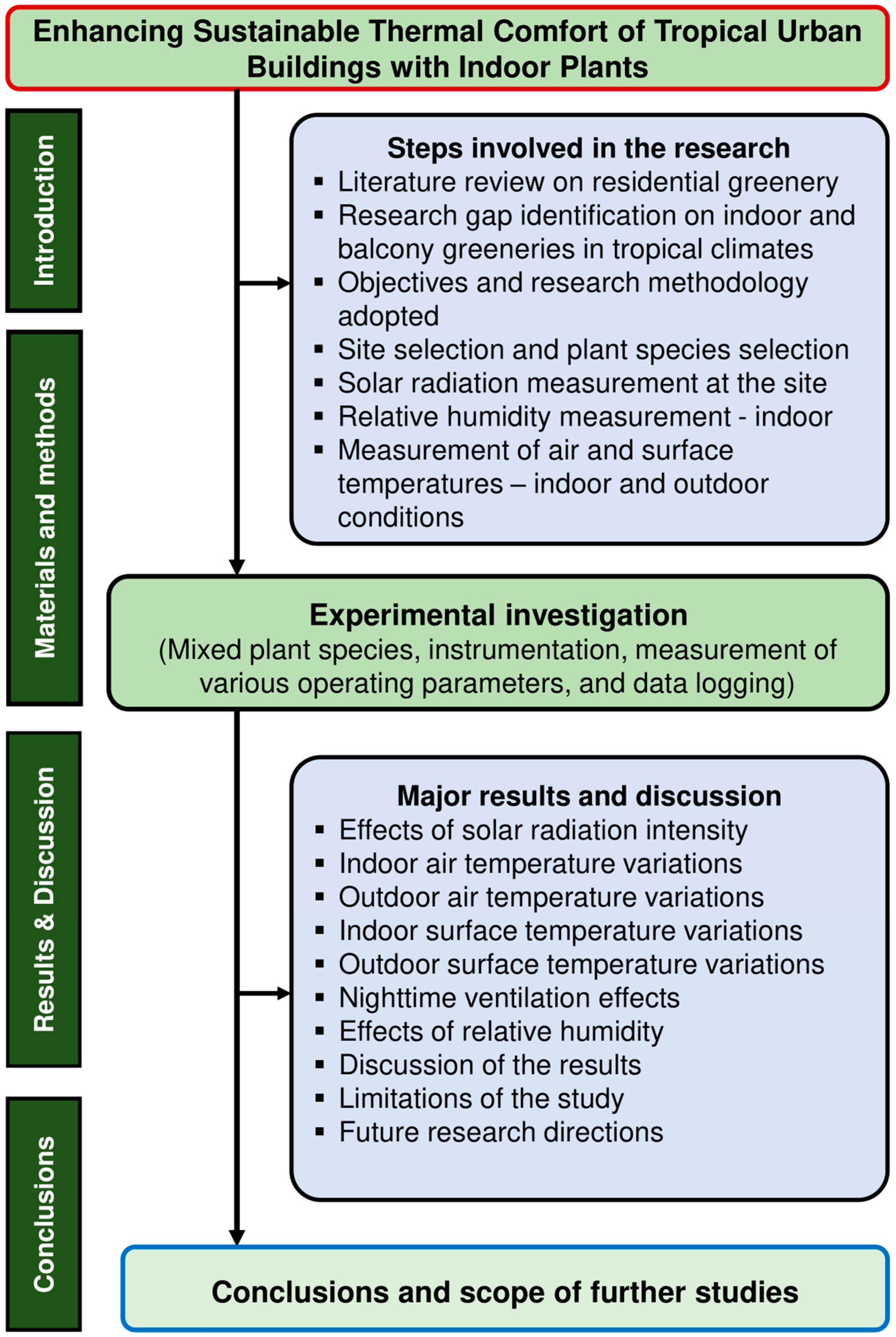
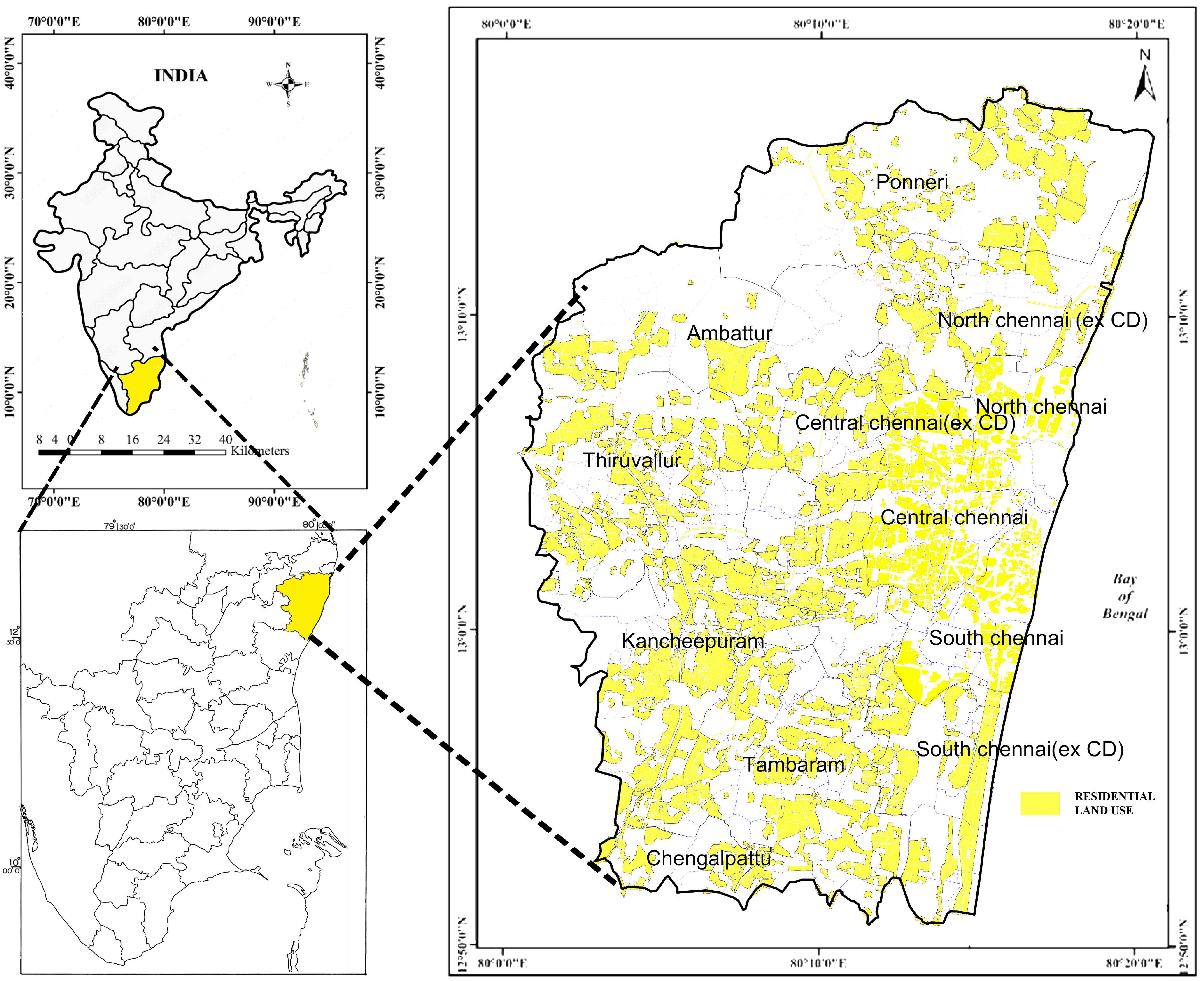

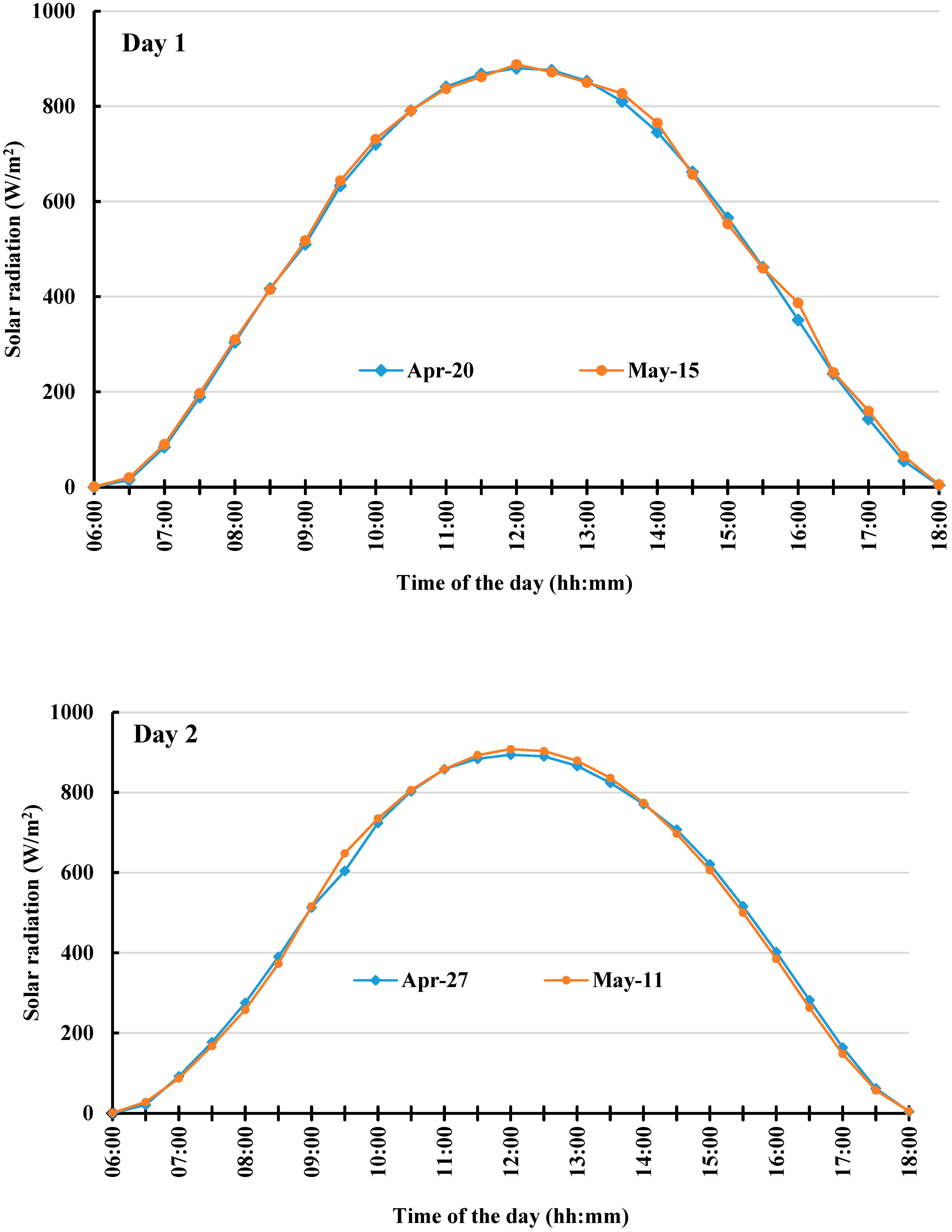
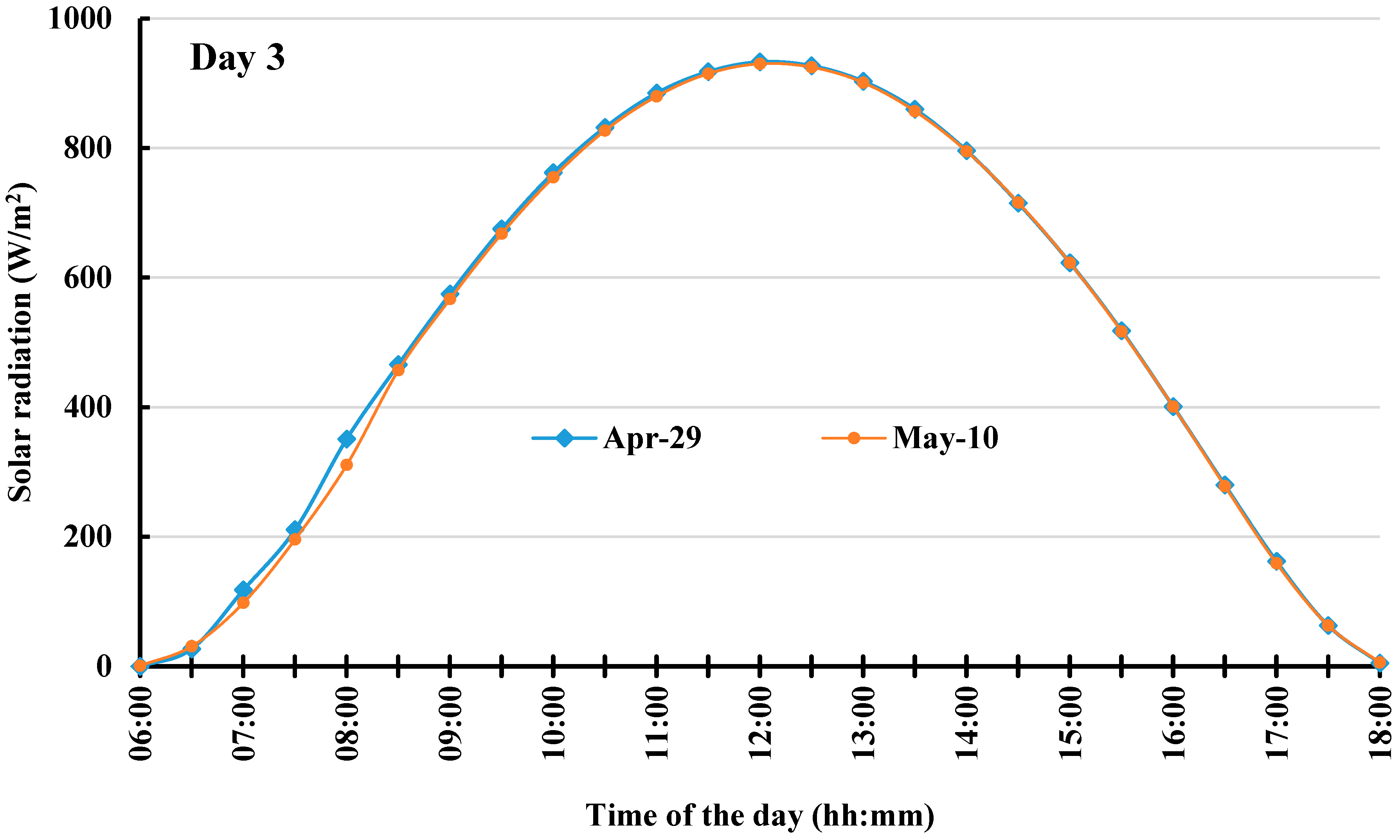

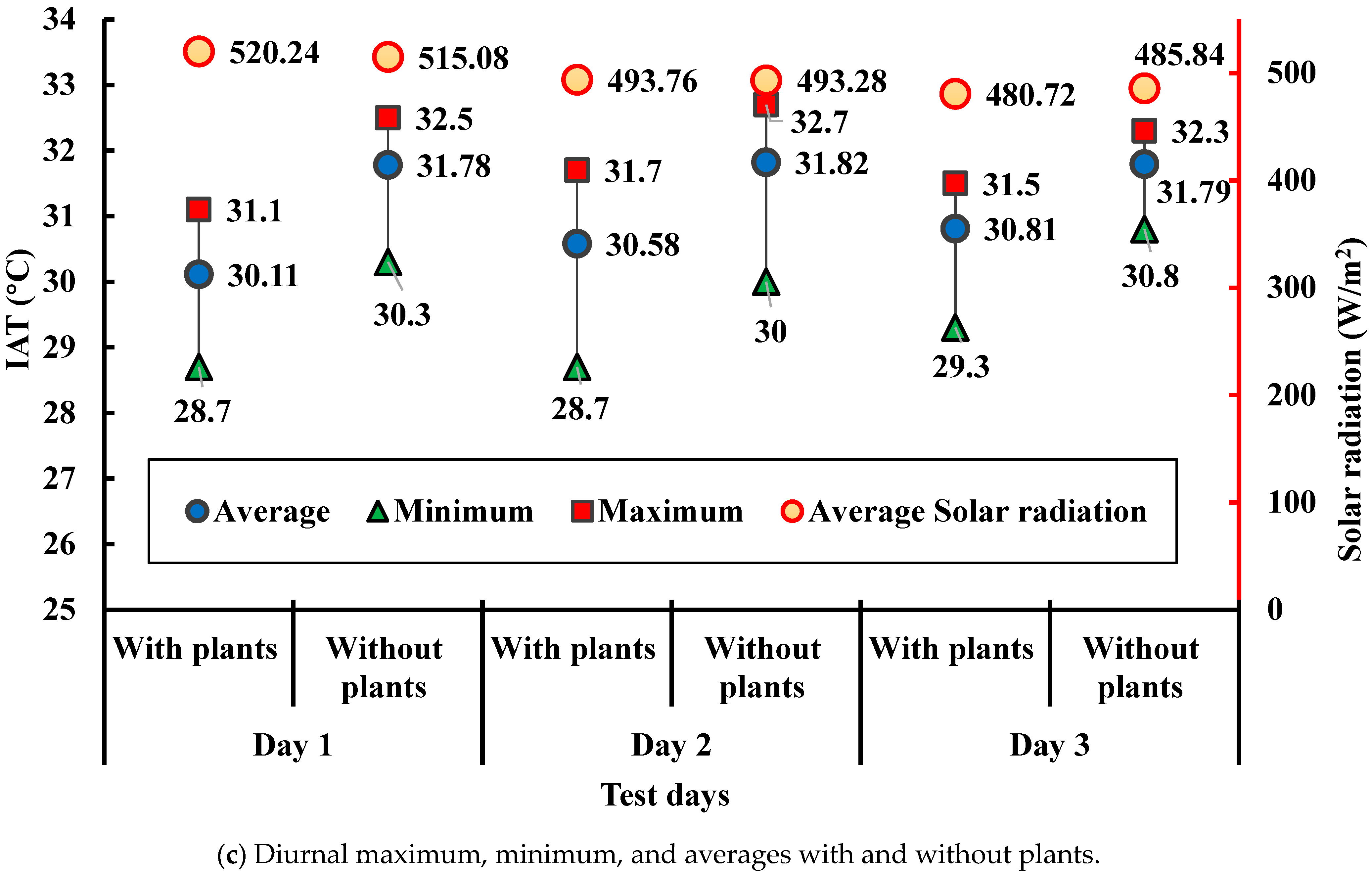

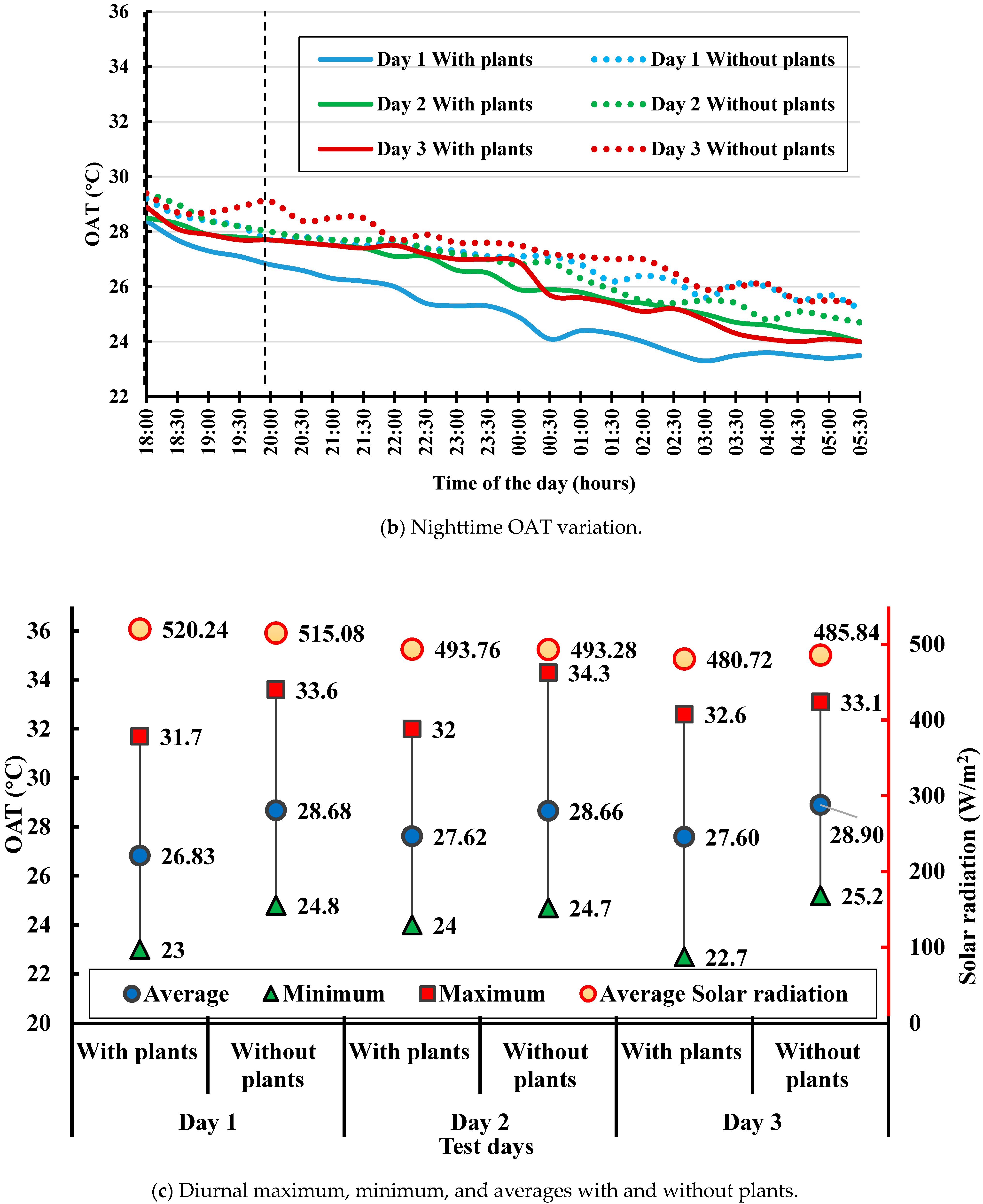
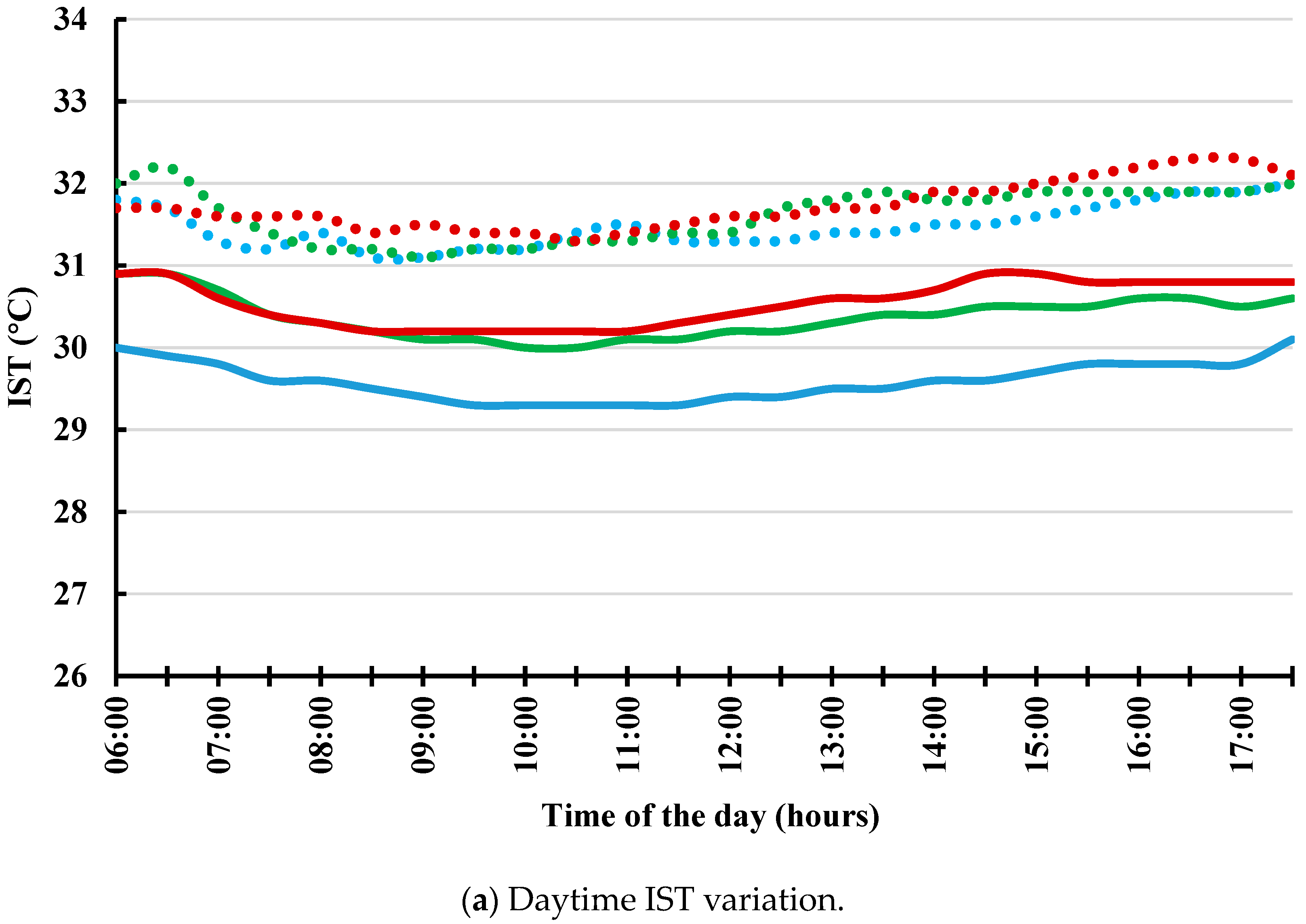
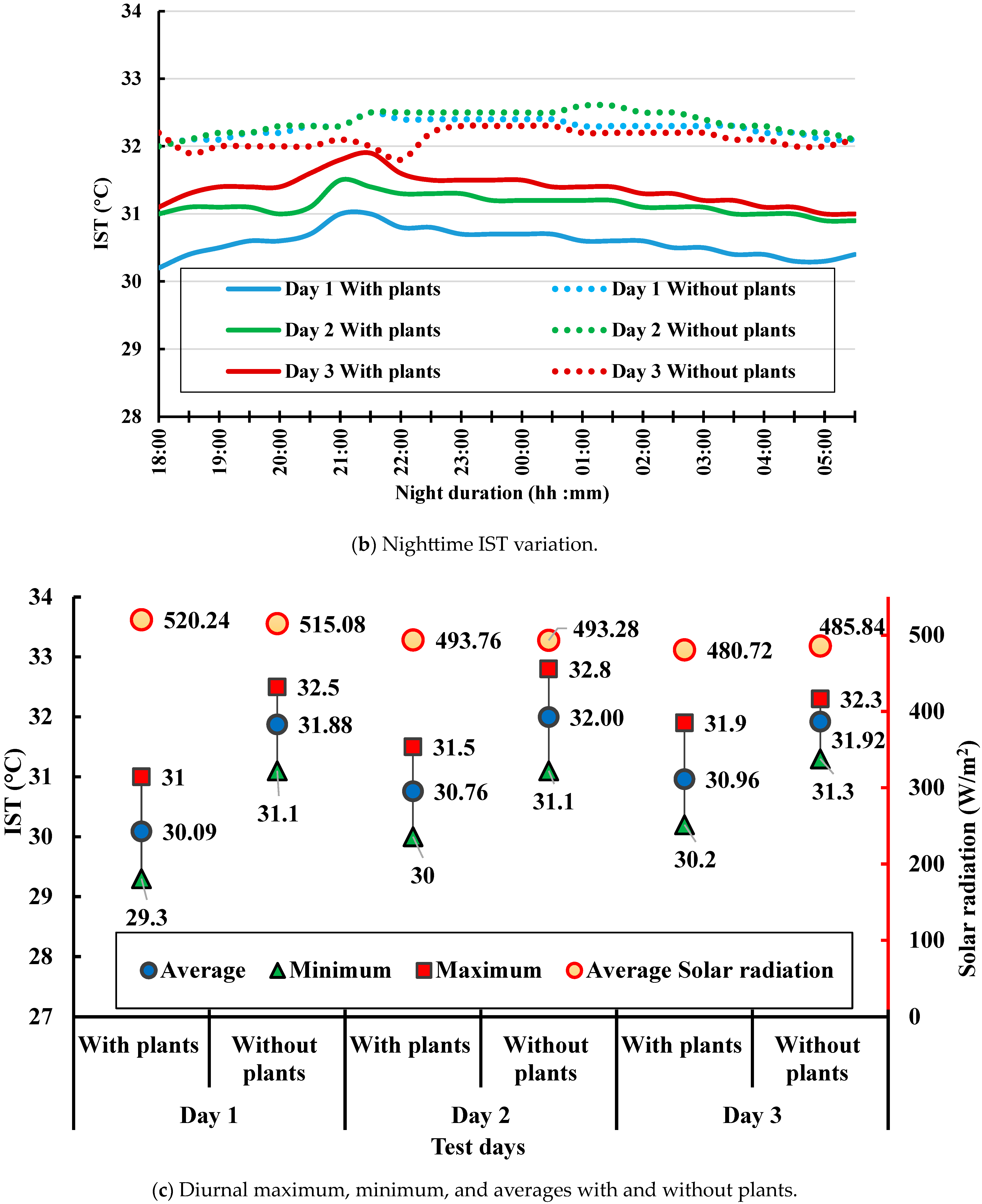
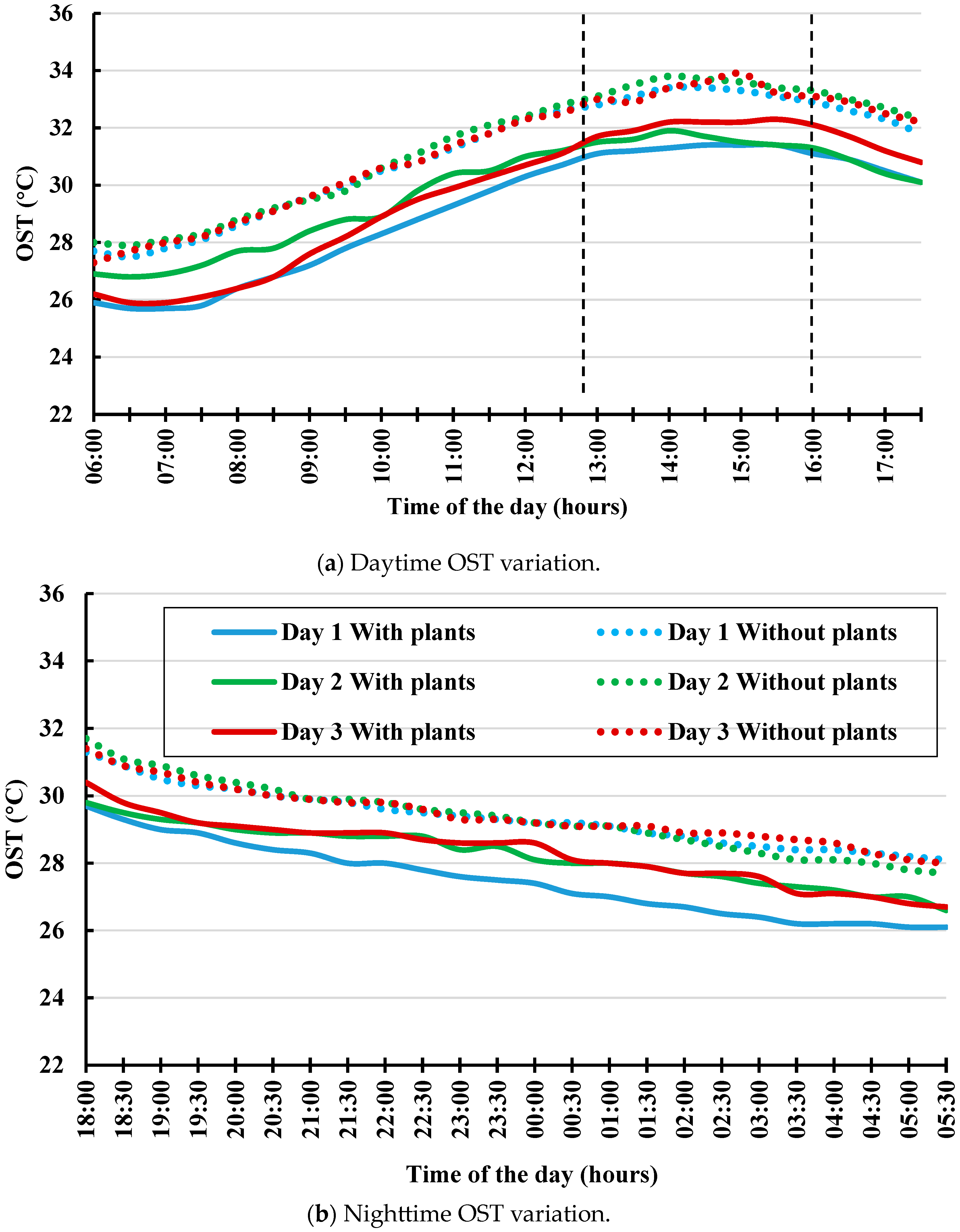
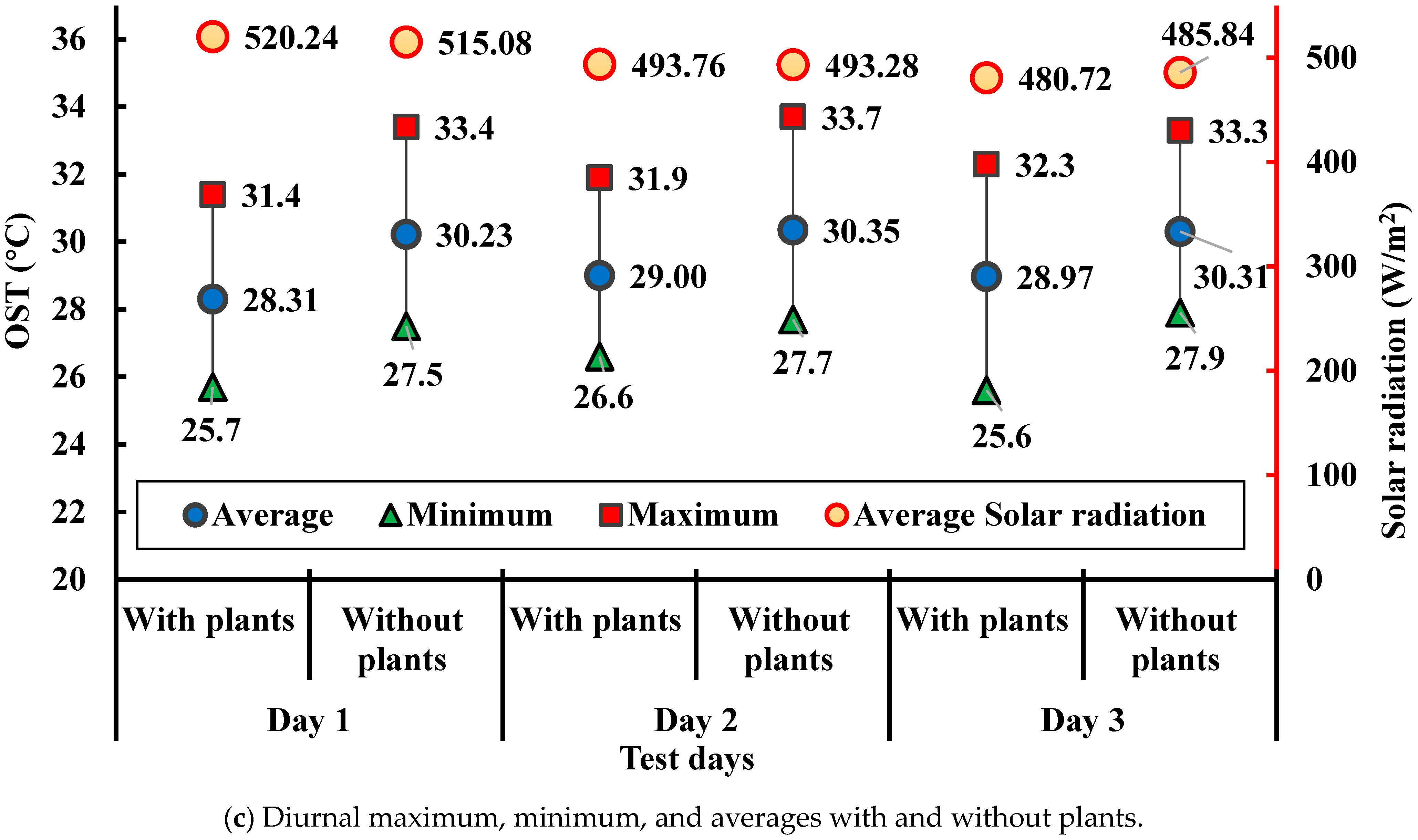
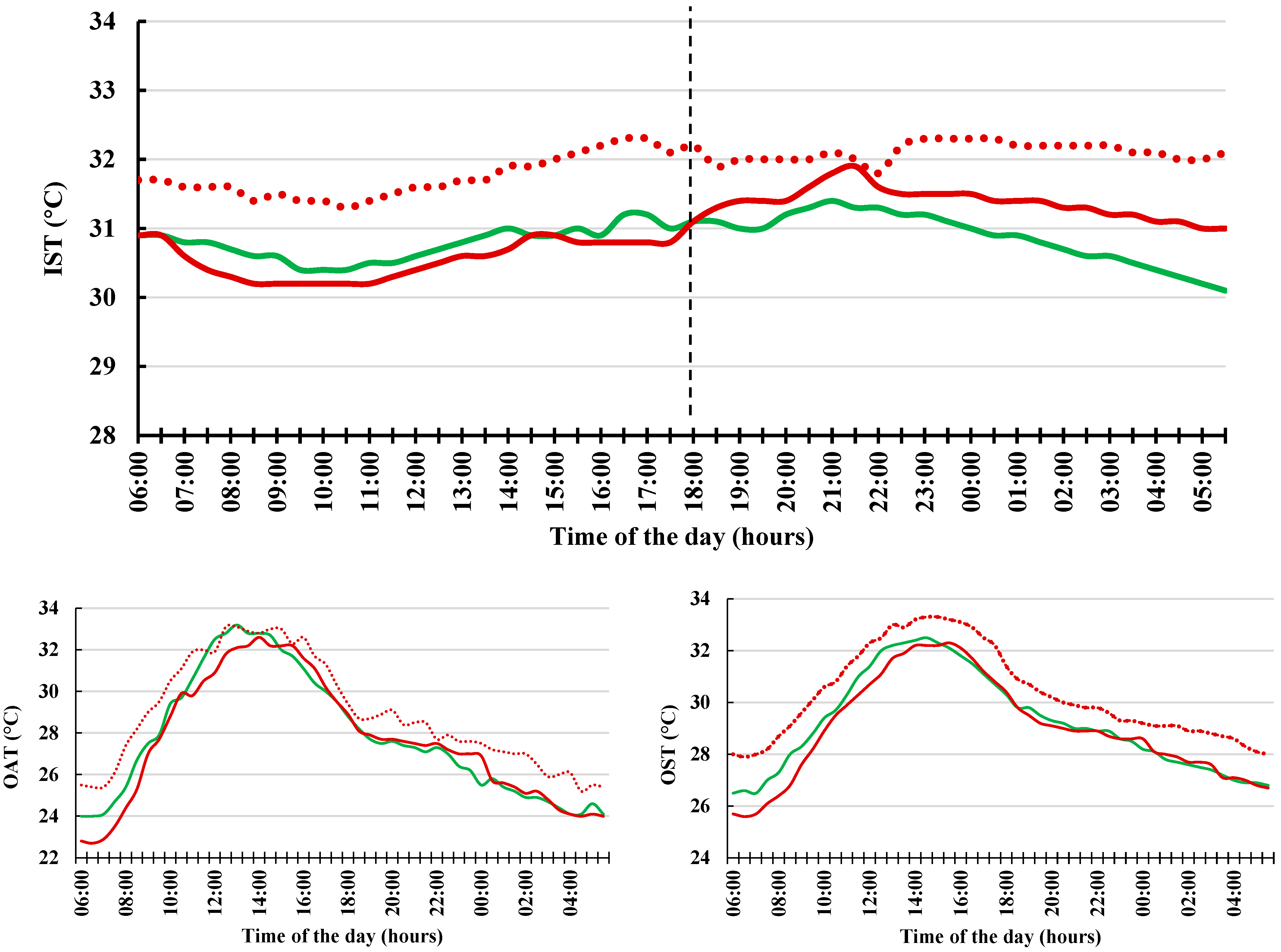
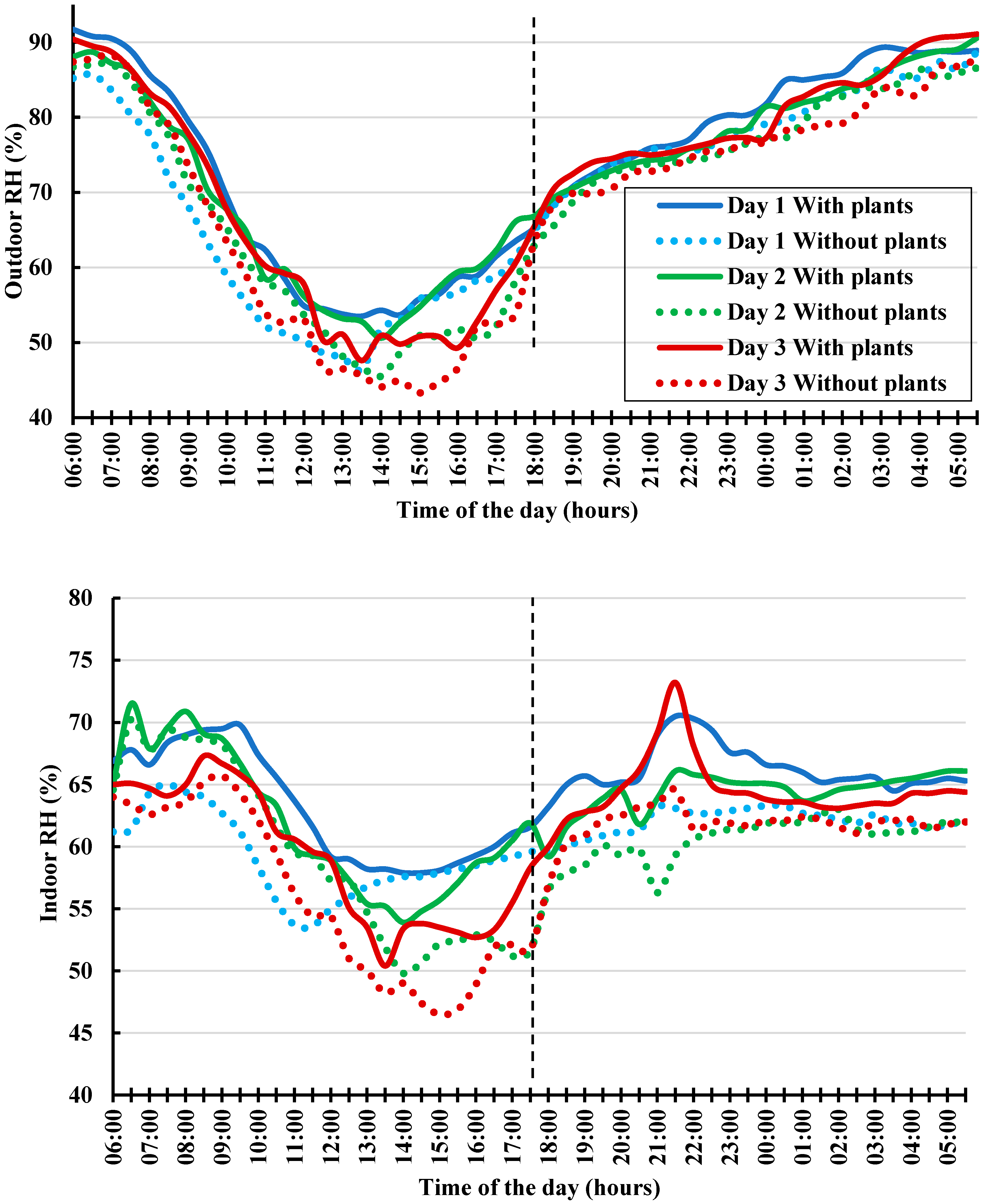

| Species | Common Name | Type | Water | Sunlight | Plant Height (mm) | Foliage Type |
|---|---|---|---|---|---|---|
| Aglaonema modestum | Chinese evergreen | Herb | Every 5 to 10 days | Shade to partial sun | 381 | Evergreen |
| Syngonium angustatum | Arrowhead plant | Climber | Every 13 days | Shade to partial sun | 1219 | Evergreen |
| Dracaena trifasciata | Snake plant | Succulent herb | Once or twice a month | Partial shade | 990 | Evergreen |
| Monstera delisiosa | Swiss-cheese plant | Climber | Every one to two weeks | Partial shade | 711 | Evergreen |
| Philodendron erubescens gold | Blushing philodendron | Climber | Once every 7 to 10 days | Partial shade | 1524 | Evergreen |
| Dracaena fragrans | Corn palm | Shrub | Every 10–14 days | Partial shade to full sun | 483 | Evergreen |
| Tradescantia spathacea | Moses-in-the-cradle | Herb | Every 10 days | Partial shade to full sun | 990 | Evergreen |
| Epipremnum aureum | Money plant | Climber | Once a week to 10 days | Shade to partial shade | 990 | Evergreen |
| Measurement | Instrument | Manufacturer and Model | Range and Accuracy |
|---|---|---|---|
| IAT OAT | Temperature sensors | Elitech GSP-6, Elitech Technology, Inc., San Jose, CA, USA | Range: −40 °C~+150 °C Accuracy: ±0.5 °C |
| Indoor RH Outdoor RH | Humidity sensors | Elitech GSP-6, Elitech Technology, Inc., San Jose, CA, USA | Range: 0–100% Accuracy: ±3% |
| IST OST | Temperature sensors | Elitech RC-5+, Elitech Technology, Inc., San Jose, CA, USA | Range: −30 °C~+150 °C Accuracy: ±0.5 °C |
| Solar radiation | Pyranometer | AT Delta-T SPN1, Delta-T Services Ltd., Maldon, UK | 0–2000 W/m2, ±10 W/m2 |
| Wind speed | Anemometer | AT Delta-T RS485, Delta-T Services Ltd., Maldon, UK | 0–40 m/s, ±0.5 m/s |
Disclaimer/Publisher’s Note: The statements, opinions and data contained in all publications are solely those of the individual author(s) and contributor(s) and not of MDPI and/or the editor(s). MDPI and/or the editor(s) disclaim responsibility for any injury to people or property resulting from any ideas, methods, instructions or products referred to in the content. |
© 2024 by the authors. Licensee MDPI, Basel, Switzerland. This article is an open access article distributed under the terms and conditions of the Creative Commons Attribution (CC BY) license (https://creativecommons.org/licenses/by/4.0/).
Share and Cite
Priya, U.K.; Senthil, R. Enhancing Sustainable Thermal Comfort of Tropical Urban Buildings with Indoor Plants. Buildings 2024, 14, 2353. https://doi.org/10.3390/buildings14082353
Priya UK, Senthil R. Enhancing Sustainable Thermal Comfort of Tropical Urban Buildings with Indoor Plants. Buildings. 2024; 14(8):2353. https://doi.org/10.3390/buildings14082353
Chicago/Turabian StylePriya, Udayasoorian Kaaviya, and Ramalingam Senthil. 2024. "Enhancing Sustainable Thermal Comfort of Tropical Urban Buildings with Indoor Plants" Buildings 14, no. 8: 2353. https://doi.org/10.3390/buildings14082353
APA StylePriya, U. K., & Senthil, R. (2024). Enhancing Sustainable Thermal Comfort of Tropical Urban Buildings with Indoor Plants. Buildings, 14(8), 2353. https://doi.org/10.3390/buildings14082353







